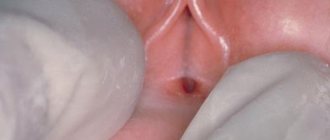Services table
| Service name | Price |
| Promotion! Initial consultation with a fertility specialist and ultrasound | 0 rub. |
| Repeated consultation with a fertility specialist | 1,900 rub. |
| Initial consultation with a reproductologist, Ph.D. Osina E.A. | 10,000 rub. |
| Therapy with the drug Pimafucin sup.vagin.100mg No.3 | 370 rub. |
| Therapy with Terzhinan vaginal suppositories No. 10 | 580 rub. |
| HPV screening (15+CVM) – vaginal scraping | 1,200 rub. |
| HPV screening (21+CVM) – vaginal scraping | 3,000 rub. |
| HPV screening (4+CVM) – vaginal scraping | 800 rub. |
| Detection of STI pathogens (7+CM) – vaginal scraping | 1,100 rub. |
| Screening of microflora of the urogenital tract (13+KVM) – vaginal scraping | 1,800 rub. |
| Femoflor-17+KVM - vaginal scraping | 2,500 rub. |
| Femoflor-7+KVM - vaginal scraping | 1,200 rub. |
| Femoflor-9+KVM - vaginal scraping | 1,500 rub. |
| Program "Women's Health after 40" | RUB 31,770 |
Childhood vaginitis: treatment
What treatment measures should be taken for children with vaginitis? To begin with, it is worth mentioning why such a problem can even affect children.
The main reason for the infection to enter a girl’s vagina is the failure to observe basic hand hygiene and the child’s habit of constantly examining their own genitals.
Streptococci and staphylococcus can be transferred to the genitals from the oral cavity, and various types of bacteria, such as E. coli, fungi and dysentery, can be transferred from the child's rectum.
But there are other reasons that can provoke vaginitis in a child. This:
- Infection with worms;
- The use of antibiotics such as Penicillin and Tetracycline by parents in the treatment of children without medical prescription;
- Placing foreign objects in the child's vagina;
- Wearing synthetic underwear;
- The use of certain hygiene products that may cause irritation.
How to treat vaginitis in children? Before talking about this aspect, you need to know how pathology manifests itself in childhood. The main clinical manifestations of childhood vaginitis are considered to be:
- Redness and swelling of the genitals;
- Painful sensations that the child complains about when urinating;
- White or yellowish discharge that has a specific odor. Such discharge usually remains on children's underwear. This should alert parents.
Getting pregnant with vaginitis: complications
Statistics show that colpitis manifests itself in one way or another in seventy to eighty percent of women during pregnancy. It can appear at any stage of pregnancy, but the most dangerous period is the period before delivery.
How can colpitis be dangerous for a pregnant woman and her fetus?
- The baby may be born premature;
- After childbirth, there is a high risk of the onset of purulent-inflammatory processes;
- During the birth itself, a woman can suffer significantly from ruptures;
- The patient may experience both oligohydramnios and polyhydramnios;
- The infection can take an upward path and spread to the entire body, its most important organs and systems;
- Pregnancy may be terminated altogether;
- There is a high risk of premature rupture of water in a pregnant woman;
- A woman can often suffer from toxicosis;
- There is a high risk of preeclampsia;
- The fetus may also become infected;
- The fetus may suffer from lack of oxygen. The consequences of this will later be noticeable in the form of developmental delays.
Childhood vaginitis: treatment and diagnosis
Treatment of vaginitis in a girl involves, first of all, careful monitoring of your own child. If a parent detects the above manifestations, then an urgent need to seek medical advice. You should not try to cure the disease yourself.
During the consultation, the doctor will carefully question the mother about the manifestations of the pathology and examine the child. The labia majora will be examined first. If the doctor suspects that there may be a foreign body in the vagina, a vaginoscope will be used for examination. If such a need arises, disinfection procedures will need to be carried out.
If there is a suspicion of a disease, the following diagnosis should be made: it is necessary to take a smear, tests for the presence of infections such as chlamydia, trichomoniasis and gonorrhea, and also do a bacterial culture to determine sensitivity to antibiotics.
Consequences
If the pathology was detected on time and the parents immediately sought medical help, then it will not be difficult for a specialist to correctly diagnose the disease, as well as prescribe the correct treatment regimen. In this case, the prognosis for recovery will be favorable, because complications will not develop in the future.
If left untreated, vulvovaginitis becomes a chronic form of the disease, which leads to the formation of unnatural adhesions on the lining of the vulva and vagina. Complications in this situation are quite serious, since inflammation begins to spread to the uterine appendages, which can cause menstrual irregularities and infertility.
Treatment of vaginitis in children: more details
When the causative agent of childhood vaginitis has already been identified, it is necessary to eliminate it first. A course of multivitamins and immunomodulators will help with this. Sometimes, to treat vulvitis, it will be indicated to take antibiotics. But since this is a rather serious drug, everything must be done under strict medical supervision.
After treatment is successfully completed, it will be necessary to restore the vaginal microflora through the use of eubiotics.
Some women suffered from vaginitis in childhood. This does not affect reproductive function in any way if correct and timely treatment was carried out. Moreover, if this was carried out with the participation of an experienced specialist, the disease will not recur. This indicates the possibility of a positive treatment outcome.
Some parents categorically do not accept traditional medicine, and then traditional medicine recipes can come to the rescue.
Bacterial vaginosis - symptoms
The acute form of the disease makes itself felt immediately after a change in the composition of the microflora. Symptoms are most pronounced during menstruation and after sexual intercourse. Bacterial vaginosis is accompanied by the following symptoms:
- Discomfort when urinating;
- Thick white or grayish discharge;
- The appearance of a stale fish smell from the vagina;
- Redness of the mucous surface of the genital organs;
- Pulling pain down the abdomen;
- Itchy and burning sensations.
A characteristic symptom of the disease is the smell of rotten fish. It is the result of the release of volatile amines, which are a product of the vital activity of pathogenic microorganisms. The discharge at the very beginning of the development of the disease is white. With a prolonged course of bacterial baginosis, they become yellow.
As the disease progresses, the symptoms intensify. On this basis, the psychological state also suffers. The risk of developing neurosis and depression increases. With chronic bacterial vaginosis, rare periods of improvement may be observed.
Vaginitis in girls: how to treat (traditional medicine)
How to treat vaginitis in girls in a safer way than using pharmaceutical products? Folk wisdom accumulated over the years, which relies on the use of natural remedies, can help with this. But it is still advisable to consult a doctor before starting to use such remedies.
- You need to take thyme, chamomile flowers and oak bark in equal proportions. The mixture must be poured with boiling water and left for a third of an hour. The infusion is excellent for treatment with tampons and irrigation;
- Pour a large amount of boiled water over some pine branches. Next, simmer the mixture over low heat for half an hour, then leave for an hour. Use for preparing hot baths;
- You need to prepare yarrow, oak bark, rosemary and sage leaves. Pour boiling water over the mixture and simmer for five to ten minutes with the lid closed over low heat. The broth must be cleaned after this and used for douching.
- Of course, traditional medicine cannot be considered a panacea against childhood vaginitis, but it can be an excellent adjuvant treatment.
Acute vaginitis in a child: how to treat?
Acute vaginitis in a girl at 5 years old, vaginitis at 2 years old - what to do in such a situation?
Acute vaginitis in girls affects the vaginal mucosa and labia. It can appear in children of all ages, but statistics show that girls between the ages of ten and fourteen are most susceptible to developing the disease.
In order to cure acute vaginitis in a child, you need to apply complex treatment. This should include the use of anti-inflammatory drugs, antibiotics and local therapy, which will alleviate the clinical manifestations in the child.
Also at this stage it is useful to use immunostimulants, which will increase the body's resistance against bacteria and infections that attack it. If the doctor prescribed anti-inflammatory therapy, but it did not have the desired effect, then you will have to start treatment with antibiotics. It must be strictly controlled by the doctor himself. Pediatric gynecologists often prescribe Polygynax Virgo. The course of treatment with the drug is approximately six days. The decision to continue or discontinue therapy is made by the doctor.
Acute vaginitis in girls is an inflammatory process that affects the vaginal mucosa and outer labia. It develops in children of different ages, but most often appears at 10–14 years of age. In order to diagnose it in a timely manner, it is necessary to visit a pediatric gynecologist for a preventive examination and monitoring the development of the genital organs and system.
Causes
Pediatric gynecologists identify several main reasons for the development of acute vaginitis in girls. Most often, the disease is provoked by age-related changes (10–14 years), when puberty begins and the body’s defenses and resistance to various infections significantly decrease. When immunity declines, the reproductive system also suffers: the microflora of the vagina deteriorates, which contributes to the development of infection and inflammation in it.
Failure to comply with basic hygiene rules can also lead to acute vaginitis. Many girls, not knowing how important this is, neglect washing, do not change their linen regularly, or do not change sanitary pads in a timely manner.
Acute respiratory diseases (tonsillitis, otitis, tonsillitis, etc.), for the treatment of which antibiotics were used, can also provoke diseases. Such drugs contribute to the development of dysbiosis and decreased immunity.
Less commonly, the cause of the development of acute vaginitis in girls can be mechanical damage to the vagina or labia, entry of a foreign body, or infection from other family members when using the same hygiene items. It is extremely rare that the disease is caused by helminthic infestations.
Symptoms
Vaginitis in children manifests itself quite acutely and has very clear symptoms. First of all, the girl is worried about a specific discharge from the genitals, which has an extremely unpleasant odor. In the area of the labia, redness of the skin and mucous membranes is observed. The girl suffers from severe itching and may experience pain and burning during urination. In some cases, there is an increase in body temperature.
The symptoms of the disease also depend on the cause of the disease. So, if vaginitis is caused by helminthic infestations, the child suffers from pain in the lower abdomen, and at night he grinds his teeth. When a foreign body enters, heavy discharge begins and redness appears in the labia area.
Bacterial vaginosis - causes
Bacterial vaginosis develops under the influence of internal or external factors. It is not classified as a sexually transmitted infection transmitted through sexual intercourse. To identify the disease, use the ICD-10 code: B96.
The trigger mechanism is a decrease in lactobacilli against the background of an increase in opportunistic organisms, which include:
- Atopobium;
- Mycoplasmas;
- Bacteroides;
- Leptotrichia;
- Peptostreptococcus;
- Gardnerellas;
- Peptococci.
An increase in the number of pathogenic microorganisms most often provokes a weakening of the body after suffering from an illness or treatment. Surgery and abortion increase the risk of developing bacterial vaginosis. Internal factors that provoke the disease include:
- Poor circulation in the pelvis;
- Hormonal changes;
- Immune disorders;
- Disturbance of intestinal microflora.
Among the exogenous causes of changes in the vaginal microflora are:
- Violation of intimate hygiene rules;
- Long-term antibacterial therapy;
- Regular insertion of foreign objects into the vagina (vaginal suppositories, contraceptive IUD, pessary and hygienic tampons);
- Eating large amounts of junk food;
- Wearing underwear made of low-quality materials;
- Abuse of douching;
- Change of sexual partner.
Treatment
Complex treatment is used, which includes taking anti-inflammatory drugs, antibiotics and the use of local therapy to alleviate the child’s condition.
In most cases, anti-inflammatory medications provide improvement. At this stage, immunostimulating drugs are also used, which strengthen the body’s resistance to bacteria and infections, and also promote a speedy recovery.
In the absence of positive dynamics from anti-inflammatory therapy, antibiotics are prescribed. Quite often, pediatric gynecologists prescribe Polygynax Virgo. The course of treatment is 6 days and is performed before bedtime after all hygiene procedures. To administer the emulsion, the capsule is incised and its contents are introduced into the girl’s vagina. This drug has antibacterial, anti-inflammatory and antipruritic effects.
Local therapy will help get rid of itching, redness, discharge and unpleasant odor. To do this, wash the external genitalia and take a bath with herbal decoctions. You can prepare an infusion from chamomile, calendula, St. John's wort and sage. All these plants have anti-inflammatory, restorative and antibacterial effects. For topical use, potassium permanganate or an oil solution of vitamin A can also be used.
Additionally, creams and ointments may be prescribed that relieve the symptoms of the disease and its consequences.
- Fenistil helps cope with acute allergic reactions. The gel is applied to the external genitalia to eliminate redness and itching.
- Actovegin is used to treat ulcers and erosions that appear after vaginitis.
- Solcoseryl is used to prevent gluing of the walls of the genital organs.
- Ovestin improves the microflora in the vagina. Prescribed for girls over 10 years of age.
After complete recovery, restorative therapy is required. A pediatrician and gynecologist recommend probiotics to normalize the microflora in the vagina and intestines and vitamin and mineral complexes to strengthen the immune system.
Treatment of colpitis during pregnancy
We will not open America to you if we tell you that colpitis cannot be treated on your own. Only a competent obstetrician-gynecologist will be able to determine what caused colpitis. Based on the test results, he will prescribe treatment. Keep in mind that a pregnant woman is responsible not only for her own health, but also for the health of the baby.
As a rule, to treat colpitis during pregnancy, chemical medications (including antibiotics), physiotherapy, herbal decoctions, baths with an acidic environment, ointment applications, and a special diet are used.
Treatment of vaginitis in pregnant women is complicated by the fact that many effective medications are not approved for them. For example, widely used drugs, such as nolicin, dalacin, clindacin, have contraindications during pregnancy. And of the other systemic ones (those that are taken orally and act when absorbed into the blood), only nystatin and pimafucin can be used. They are safe even in large doses, but, unfortunately, they are ineffective. Therefore, treatment with these drugs is combined with local treatment (douching with herbal decoctions, taking sitz baths, using vaginal and rectal suppositories, creams or gels).
The popular drug betadine can only be used up to 3 months of pregnancy. At the same time, Terzhinan and Vagotil have no contraindications for pregnant women. As for antibiotics, they are prescribed only after determining the sensitivity of the pathogen to drugs of this series.
If the cause of colpitis is an infection caused by Trichomonas, the doctor prescribes Metronidazole. True, this drug is contraindicated in the 1st trimester of pregnancy, but if necessary, it can be used during the 2nd and 3rd trimesters. Pregnant women with trichomonas colpitis are prescribed Clotrimazole (in the vagina, 100 mg daily for a week). But this only results in a weakening of the symptoms. Cure occurs only in 1/5 of the patients.
Although tetracycline is often used in gynecological practice to treat vaginitis, it should not be prescribed to pregnant women.
Possible complications and prevention
If acute vaginitis in a girl is not detected and treated in a timely manner, there is a high probability of developing a number of complications. Synichea (complete or partial fusion of the labia) is most common; condylomas and polyps occur less frequently. A severe form of the disease provokes deformation of the genital organs, disrupts the functioning of the reproductive system, which in the future can lead to infertility. The most serious complication is the formation of a tumor, which can later develop into a malignant cancer.
To avoid the development of the disease, it is necessary to accustom the girl to hygiene from infancy, telling the basic rules of self-care. At an older age, parents should help their child keep the genitals clean and healthy. In addition, proper nutrition, physical activity and proper rest play an important role in maintaining a healthy lifestyle for girls.
It is also important to create a trusting relationship so that the child, if pain or discomfort occurs, does not hesitate to talk about it with his parents. This will allow timely detection of the disease and avoid complications.
This article is posted for educational purposes only and does not constitute scientific material or professional medical advice.
The incidence of inflammatory processes in the area of the external genital organs in girls at different periods of life varies, according to a number of authors, from 30 to 93%. But not only this determines the clinical significance of this pathology, but also the fact that in the absence of adequate treatment, vulvitis in girls can lead to serious problems of the reproductive system in adulthood.
Types of vaginitis in pregnant women
In gynecology, there are several types of vaginitis, but in pregnant women the most common is the abacterial form, as well as nonspecific bacterial vaginitis. They have similar symptoms, only the nature of the discharge changes. Treatment tactics will also be slightly different.
Abacterial
There are many factors that can cause inflammation. In some cases, a woman is not infected with either bacteria or viruses, so gynecologists talk about the abacterial form of vaginitis. This disease can occur during pregnancy due to a decrease in the body's defenses.
Secondary causes of non-bacterial acute vaginitis are:
- increased sensitivity to household chemicals or intimate hygiene products;
- installation of a pessary in case of threat of spontaneous abortion;
- uncontrolled treatment with antibacterial drugs or their incorrect selection;
- improper douching or use of solutions not intended for this procedure;
- diabetes;
- increased body mass index;
- deviation in the functioning of various glands.
Also, the cause of vaginitis in pregnant women may be injury to the mucous membrane during any diagnostic measures, and in some cases, prolapse of the genitourinary system.
Candida
A decrease in the functions of the immune system, especially barrier functions, is not a deviation during pregnancy, but it does entail a change in the balance of microflora in the vagina. The situation is aggravated by hormonal imbalance - another constant “companion” of a pregnant woman. The expectant mother's body produces more progesterone than necessary. This hormone affects the amount of glycogen, the food product of lactobacilli that live in the vaginal mucosa.
If the balance of microflora has changed and there are fewer of these bacteria, the glycogen level increases and the acid-base environment changes. As a result, favorable conditions are created for the growth of opportunistic microflora and some fungi that can live hidden in tissues for several years. This is how candidal vaginitis occurs in a pregnant woman.
Bacterial
Bacterial vaginitis can be nonspecific and specific. In the first case, the development mechanism is the same as with candidal vaginitis, but the disease is caused by opportunistic microflora - some staphylococci and streptococci, E. coli and other bacteria. They constantly live on the mucous membranes of the vagina, and can also be introduced into it from the rectum if personal hygiene rules are not followed. Once in favorable conditions, microorganisms begin to multiply rapidly, damaging the mucous membrane, which causes an inflammatory process.
Specific bacterial vaginitis in pregnant women is always caused by sexually transmitted infections. These include:
- gardenerella;
- chlamydia;
- Trichomonas.
A woman can become infected through unprotected sexual intercourse, as well as through the use of someone else's personal hygiene products.
In especially severe cases, mixed vaginitis is possible. This is a disease in which there are several causative agents of the inflammatory process. For example, Trichomonas are “enhanced” by the proliferation of fungi of the genus Candida. Mixed bacterial vaginitis is the most difficult to treat, especially when it comes to the early stages of pregnancy.
The problem of vulvitis in girls
Vulvitis is an inflammatory process affecting the area of the external genitalia (from the Latin vulva - a collective concept that unites all anatomical structures related to the external female genitalia).
Vaginitis is inflammation of the vaginal mucosa (lat. vagina).
The most common is a combined lesion of the vulva and vagina - vulvovaginitis, which occupies a leading position in the structure of gynecological diseases of childhood. Most often, girls are susceptible to the disease during the “neutral” period of sexual development - from one month to 8 - 9 years - which is explained by the functional immaturity of the genital organs, and, importantly, the insufficient activity of the immune system and endocrine glands at this age.
Diagnostics
If there is a suspicion that vulvovaginitis is developing in a girl, how to treat this disease is determined by the doctor after a thorough diagnosis of the patient’s body. First of all, the cause is determined, as well as the type of pathogen. To do this, a pediatric gynecologist will examine the external genitalia and take smears to study the composition of the microflora.
If there are indications, then vaginoscopy and cerviscopy may be prescribed. During a visual gynecological examination, the doctor must note whether there are signs such as swelling of the genital organs, redness of the mucous membranes, the presence and nature of vaginal discharge.
The etiology of the pathology is determined only after receiving the results of the smear examination. If the inflammatory pathology progresses, a large number of leukocytes will be noted. It is thanks to microscopy that the doctor is able to accurately determine the type of pathogen that causes the disease. Also, if necessary, they can perform a polymerase chain reaction, which is a more accurate technique because it shows urogenital infections.
It is imperative to carry out a differential diagnosis to determine whether there is specific or nonspecific vulvovaginitis. In this situation, you may need to undergo consultation and examination with such specialists as an allergist and endocrinologist. An ascending infection cannot be ruled out, in which the patient has pain in the lower abdomen. In case of such complaints, an ultrasound scan of the pelvic organs is required.
Based on all the data that the specialist receives during diagnosis and determination, he will determine that the girl has vulvovaginitis. How to treat this or that type of disease will become clear after a complete analysis of the patient’s clinical condition. We will talk about standard treatment regimens in more detail below.
Age characteristics of the genital organs of girls and adolescent girls
Children's genitals have a number of anatomical and physiological features that do not always allow them to adequately resist the infectious process. Common features include:
- weak closure of the labia minora and majora in the posterior regions;
- the mucous membrane has a small number of folds;
- the epithelium of the reproductive tract is thinned, cell reproduction and renewal are slow;
- low level of humoral protection factors (interferons, etc.) in vaginal secretions;
- coccal flora predominates;
- The baby's vagina has a neutral or alkaline pH level.
Features of the microflora of the genital organs in girls, depending on age and hormonal levels, are reflected in Table 1.
The newborn period directly depends on the maternal hormones supplied to the baby through the placenta. The mother's estrogens stimulate the epithelial cells of the girl's vagina, which mature, become keratinized, accumulate glycogen, and, in general, function like those of an adult woman. The vagina is populated with lactoflora, which protects the mucous membranes from the proliferation of pathogens. Lactobacilli produce hydrogen peroxide, stimulate the formation of interferon and immunoglobulins, due to which vulvovaginitis practically does not occur in girls in the first three weeks of life.
How does bacterial vaginosis develop?
A huge number of microorganisms live on the vaginal mucosa.
They perform protective functions by triggering the body's immune response. The main part of the vaginal microflora is represented by lactobacilli. Thanks to them, an acidic environment is created in the woman’s genitals. Lactobacilli ensure the breakdown of glycogen, which promotes the production of lactic acid. Strict anaerobes and bifidobacteria are present in some quantities in the microflora. Significant changes occur in epithelial cells. The acidic environment of the vagina becomes alkaline. As a result, the amount of vaginal secretion increases. A distinctive feature of the disease is the absence of a specific pathogen. Therefore, treatment of bacterial vaginosis requires an integrated approach.
The main pathogens and factors contributing to the development of vulvitis in girls
Of course, the anatomical and physiological features of the structure of the genital organs play a certain role in the development of inflammatory diseases, but everyone has them, but vulvitis and vulvovaginitis, fortunately, do not occur in all girls. What is the trigger for the development of inflammation? All factors can be divided into predisposing and causal.
Causal factors can be infectious or non-infectious.
Non-infectious factors
Non-infectious include:
- mechanical (injuries, foreign bodies, helminthic lesions);
- chemical (washing with concentrated solutions);
- thermal (hot water, overheating due to untimely changing of diapers);
- allergic lesions of the mucous membrane.
Infectious factors
Infectious factors:
It should be noted that it is infectious factors that play a leading role in the development of vulvitis and vulvovaginitis.
Bacteria, according to a number of authors, cause up to 75% of cases of vulvitis in girls in the “neutral” period. In this case, most often, with the help of laboratory tests, nonspecific flora is detected: Escherichia coli, staphylococci (aurus and/or epidermal), streptococci, enterococci, peptostreptococci, bacteroides. Specific pathogens (Trichomonas, chlamydia, urea and mycoplasma, etc.) are rare in children. Inflammatory processes caused by these pathogens require a special approach to diagnosis and treatment; we will omit their discussion for now.
In recent years, there has been an increase in the specific number of vulvitis caused by several pathogens at once (microbial associations), which forces specialists to reconsider approaches to treatment.
Viruses account for 10 to 25% of vulvovaginitis. Most often, herpetic lesions of the vulva occur in girls aged 1 to 6 years. Less commonly, inflammation can be caused by adenoviruses, paramyxoviruses, etc.
Vulvovaginal candidiasis in children before puberty is not common, usually due to a severe decrease in immunity and the use of antibiotics.
What is the probability of getting pregnant 5 days before menstruation?
Girls who are too early to have children should be attentive to sex and methods of contraception. Not all of them will be happy about an unplanned pregnancy. Many people do not believe that it is possible to conceive a child a few days before the start of menstruation and therefore should not be afraid to engage in activities that are not protected by love, but it would be worth it. Doctors insist that you can get pregnant 5 days before your period, since each body is individual. Is it possible to get pregnant 5 days before your period? Let’s take a closer look.
Important points of the menstrual cycle
There are no special rules and conditions for the female body to begin conception. Each body has its own characteristics, so women differ from each other. The lifestyle, body changes and menstrual cycle are not the same for everyone, and the same thing happens with conception. Some people may become pregnant a few days before their period, while others are not bothered by such days at all. To begin with, you should know what happens in the female body five days before the critical days.
Have you been fighting CYSTITIS for many years without success?
Head of the Institute: “You will be amazed at how easy it is to cure cystitis by taking it every day...
Read more "
When a girl begins to plan a pregnancy, she calculates the days to ensure that conception occurs. Each woman’s menstrual cycle has its own numbers, but generally they range from twenty-one to thirty-five days. It is important to conceive precisely during the period of ovulation, since these are favorable days.
How to determine the period of ovulation
You can understand that ovulation has occurred by the following signs:
- before the menstrual period begins, a woman may observe white or transparent discharge;
- I want constant intimacy;
- emotions increase, hormones become more intense;
- The stomach begins to pull.
Those whose periods have not arrived on time should definitely see a doctor. The problem may lie not only in the failure of ovulation days, but also in the appearance of various diseases. It is not difficult to independently calculate that ovulation has occurred. Usually this is the middle of the cycle, plus or minus a couple of days.
For three days, male sperm are able to maintain their viability and can fertilize an egg at any time. Therefore, when calculating, it is worth subtracting three more days. This way you can calculate the days on which there is a high chance of getting pregnant. Now you need to understand what affects conception five days before menstruation.
Is it possible to conceive a baby five days before your period?
Every month a woman knows approximately what date her period will begin. She expects her period to come on time, but this does not always happen. Many people find that these days are delayed from one to seven days, so the chances of conception increase several times more. Women should understand that in fact, their period is not five days away, but about thirteen. In this case, ovulation will also be late and therefore you can get pregnant easily.
When unprotected sexual intercourse occurred five days before menstruation, menstruation has begun, and the woman is still nervous that she might be pregnant, it is worth taking a closer look at the nature of the discharge. If the discharge occurs as usual, and nothing strange is noticed, then conception has not occurred. The uterus is simply not ready to accept such late fertilization at this time. And when this happens, the egg is still released along with secretions and blood.
How to determine unfavorable days for conception
When a couple wants to have a child, they plan the whole process in advance, prepare for it and calculate special good days.
The opportunity to become pregnant occurs during the period when ovulation occurs. But as you know, conception occurs when the egg begins to be released from the ovary, so in order to definitely get pregnant it is not necessary to wait until the day of ovulation. To do this, you should constantly have sex without protection. If conception has not occurred within several months and sex was definitely not protected, it is advisable to go for an examination to a doctor. He will tell you what to do to make this happen and, of course, prescribe a series of tests to check everything. Basically, conception occurs if you direct all efforts and plan sexual intercourse a few days before ovulation. Thus, the chances increase several times.
Doctors do not advise having children at a time when your period should begin. But if this has already happened, then nothing can be done about it. If a child is not included in your plans, it is advisable to use special contraceptives.
What affected conception before the critical days
Each female body is individual, so some people manage to get pregnant on unfavorable days, while others wait for a favorable moment. What exactly can affect conception and how to correctly understand when to have children:
- First you need to learn how to correctly calculate favorable days. To do this, you can use a special calendar, which makes it easy to calculate the ovulation period. When unprotected sex occurs, there is always a chance of conception, regardless of what day it happens. Therefore, the phase of the cycle practically does not matter, and if a couple does not want children, then they always need to use protection.
- A couple of days before your period, a hormonal imbalance occurs, which can cause imbalance. At such moments, the body cannot secrete the required number of hormones for a certain phase of the cycle. With this disruption of hormones, their production occurs out of order, so the chances of pregnancy increase significantly.
- There is another reason that will help you find out whether you can get pregnant 5 days before your period - this is the number of ovulations. Typically their number should be one per cycle. If a woman has disorders in her body, then ovulation may occur several times in one cycle. This mainly happens if women do not have frequent sexual activity. The second period of egg maturation occurs after the last time there was intimacy. Because of this, a girl can become pregnant 5 days before her period.
Contraceptive use and pregnancy
It will be useful for everyone to find out whether it is possible to get pregnant while using contraceptives. Conception is impossible if a girl takes oral contraceptives. In order for pregnancy to occur, you need to stop taking them. If a woman does not take pills a few days before the onset of menstruation, she can easily become pregnant through unprotected intercourse.
Before you start taking oral contraceptives, you should know how to take them correctly and how they work. To do this, you need to consult a gynecologist. He will explain that when a woman takes the pills, egg maturation will not occur at all. This process is completely absent due to the use of drugs. But when a woman suddenly stops taking the pills, the body itself will begin to stimulate the growth and development of eggs. At such moments, two or more of them can develop, per cycle. If you stop taking hormonal pills on the days when menstruation should begin, then your chances of conceiving are very high.
Chances of pregnancy before menstruation
When male sperm enter the uterus, the female body begins to fight them. It happens that the sperm completely die and there are no more left. If a woman has the same partner, then the chances of conception increases. This happens because the female body gets used to one man and his sperm. As a result, the female body relaxes and allows sperm to penetrate and thus conceive. This even applies to the days leading up to your period.
If sperm are active enough, they can stay in a woman’s body for up to ten days. The child can be made during these ten days and without sexual intercourse. Also, the chances of conception increase if a man has not had sexual intercourse for a long time. The flexibility of sperm and sperm activity increases several times, and therefore conception also increases.
Frequent sex allows the female body to work like clockwork, but anything can happen. Pregnancy may not occur as planned. Of course, the probability of conception before your period is very low, but there is always a chance. Therefore, if a child is not part of your plans, use any method of contraception. It is also advisable to go to a gynecologist and consult with him, he will tell you what is best to use in order not to get pregnant, and what exactly is suitable for a woman.
A little conclusion
Now we can say with confidence that there is a chance of conception five days before the start of your period. First of all, it depends on the woman herself and the duration of the menstrual cycle. Also, a man plays an important role in this regard. If the partner is permanent, then the chances of pregnancy also increase. The activity of male spermatozoa also greatly influences conception. If a man has not had intimacy for a long time, then his sperm are very fast during this period.
If pregnancy is not included in the plans of a man or a woman, it is definitely worth starting to use contraception, since an unwanted pregnancy leads to abortion. To choose good contraceptives, it is better to consult a doctor.
×
Treatment of vulvitis in girls
Treatment of vulvitis in girls is a complex multi-stage task that requires a differentiated approach. Since both the occurrence and development of the inflammatory process depends on the general condition of the body, in most cases local treatment alone is not enough. An integrated approach is needed with the correction of the body’s defenses and the rehabilitation of chronic foci of infection.
General treatment and hygiene
Maintaining personal hygiene can speed up the healing process. It is necessary to wash an infant girl every time she changes diapers with warm running water without soap. It is recommended to use soap for genital hygiene once a week.
During treatment of vulvovaginitis, a girl older than one year (provided she refuses diapers) should be washed 3-4 times a day with warm water without soap, thoroughly cleansing the genitals of purulent discharge. During the treatment period, panties are changed after each wash. For healthy girls, a daily change of towel is recommended, but during treatment of vulvitis it is better to change the towel after each wash (it is more convenient to use during this period to dry the genitals after washing with baby diapers - they are easy to wash and dry quickly).
General treatment includes sanitation of chronic foci of infection, treatment of concomitant acute infections (conjunctivitis, rhinitis, diarrhea, bronchitis, etc.), treatment of allergic reactions, as well as the prescription of vitamins and diet therapy. During the acute period of vulvovaginitis, it is recommended to limit carbohydrates, meat broths, spices, marinades and enrich the diet with vegetables and fruits.
Local therapy
Local treatment includes mechanical cleansing of mucous membranes from secretions using medicinal solutions (furacillin, hydrogen peroxide, rivanol, chlorhexidine) or decoctions and infusions of herbs, followed by application of anti-inflammatory ointments, creams, and liniments to the affected areas.
Medicinal herbs (chamomile, oak bark, calendula, string) can be used both for washing and for sitz baths. To obtain an effective medicinal concentration, herbs are brewed at the rate of 5 - 7 grams per 1 liter of water. Before immersing the affected area in the broth, remove the discharge by washing it under running water without soap. The duration of a sitz bath is no more than 5 minutes. If you leave the child in the bath for more than five minutes, the mucous membrane will become wet, and the pathogen can penetrate even deeper, i.e. such a procedure can complicate treatment rather than speed up recovery.
as ready-made local dosage forms for the treatment of nonspecific bacterial vulvovaginitis: Levomekol, synthomycin emulsion 5 - 10%, Dalatsin cream, Levasin. To treat candidal lesions, antifungal ointments and creams are used - clotrimazole, nystatin, miconazole; for the treatment of viral lesions - suppositories with interferon, acyclovir. If necessary, the doctor can write a prescription for the preparation of the medicine at the pharmacy.
Systemic drugs
When treating vulvovaginitis in childhood, systemic drugs are rarely used. This may be necessary in case of recurrent forms of nonspecific bacterial vaginitis; in case of severe herpetic lesions, local treatment is combined with oral administration of drugs to speed up the recovery process; in case of recurrent forms of vulvovaginal candidiasis.
Traditional methods of treatment
Infusions and decoctions of medicinal herbs, which have already been described above, are used as traditional methods of treatment.
Therapy
Regardless of the cause of the disease, treatment of childhood vaginitis must be carried out, and parents must strictly follow all medical recommendations so that the child can fully recover and the achieved therapeutic effect is permanent.
The main medications that doctors prescribe are etiotropics, antiseptics, and disinfectants, but it is always better to carry out complex treatment. In this case, the main provocateur of the disease is initially eliminated, then the child’s immunity is maximized, and the composition of the microflora of the vagina and external genitalia is restored.
Vaginitis in girls is often treated with systemic and local antibiotics. In the first case, the drugs are indicated for patients whose pathology is in an advanced form, in the second, if the disease has just begun to develop. If there is nonspecific vaginitis, then broad-spectrum antibiotics will be effective.
Types of vulvovaginitis. Source: dor-lic.ru
However, with an accurate determination of the type of pathogen, the best effect will be achieved with a narrowly targeted effect on the pathogenic microorganism. If a candidiasis-type disease occurs, then therapy is carried out with antifungal agents (Miconazole cream 3%, Clotrimazole vaginal tablets 1.5%, Ticonazole ointment 6.5%).
Treatment of bacterial vulvovaginitis in a girl is carried out using Metronidazole tablets or gel, and a 3% concentration of Clindamycin cream can be offered as an analogue. If the disease develops under the influence of the genital herpes virus, the most justified will be the use of drugs such as Zovirax, Larifan, Acyclovir.
There are often cases when pathology occurs against the background of other concomitant diseases that provoke a decrease in immunity. In this situation, the primary priority should be to eliminate the root cause, that is, treat the underlying problem. It is imperative to strengthen the body, otherwise antibacterial therapy will not give the expected effect.
Let’s say that if a patient develops vulvovaginitis after being infected by helminths, it is necessary to initially remove the parasites from the body, and the type of complex therapy should be determined by the doctor. It is very important that before taking any medications, parents make sure that the child has no contraindications.
Before prescribing therapy, the specialist must collect an anamnesis, which helps him develop a treatment regimen and select medications in accordance with the individual characteristics of the patient’s body. With the right effect on the body, it is possible to stop inflammation after just a few days, but the full course of treatment is 10 days.
During this entire time, you should carefully treat the external genitalia with prescribed products, and also apply antibacterial drugs 1-2 times a day. If therapy is carried out in a hospital, then the most justified method is to sanitize the genital organs with a 4% concentration of sodium bicarbonate solution.
Applications with antibiotics and baths with a 1% solution of hydrogen peroxide are also quite effective. You can also perform such sitz baths at home, but for their preparation it is better to use decoctions of medicinal herbs (chamomile, St. John's wort, calendula). The duration of one procedure should not exceed 10-15 minutes, and the water should be taken at room temperature. Take baths in the morning and evening.











